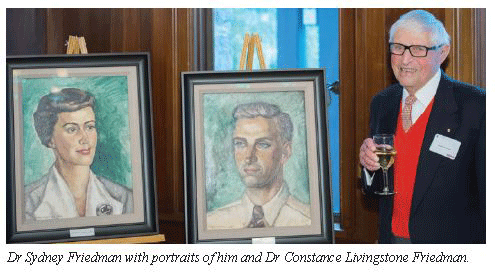Dr Sydney Friedman

Anatomy, the most traditional of the basic medical sciences, is of special historical significance with respect to the development of medical teaching at UBC.
At 33 years old, Dr Sydney Friedman was recruited from McGill to help build the new UBC Faculty of Medicine. In 1949 he was appointed as the first member and professor in the new faculty.
To introduce teaching anatomy in a new venue was challenging. He and his wife, Dr Constance Friedman, set about developing a new department and medical school. The first class of 60 students was mainly taught in large huts that had been previously built for the School of Architecture. A room in a dairy barn was the storage site for cadavers and a morgue was created adjacent to the dissecting room.
Dr Friedman’s philosophy as a teacher of anatomy was different from that of most basic scientists. Holding both research (PhD) and medical (MD) doctorates, he believed in a close correlation between the clinical and basic sciences. He worked tirelessly to encourage a strong bond between the two—both geographically and academically—and supported young medical graduates spending time in his department.
Dr Friedman fought hard to expand this concept of collaboration with clinical sciences through the vision of a university hospital. This became a reality when another renowned UBC pioneer, Dr Pat McGeer, gained political power and (according to Dr Friedman) almost single-handedly helped to establish the UBC Hospital adjacent to the existing basic science buildings.
It is significant and fitting that an anatomist should be one of the first to accept the responsibility of creating a new medical school. Anatomy has historically been the foundation on which our medical education is based. None of us will forget our first exposure to a human cadaver. Doctors remember the emotional impact of that experience and the realization that we are entering a discipline unlike any other. Dr Friedman believed in relating the teaching of gross anatomy to clinical practice, and he integrated it with histology, radiology, and neuroanatomy. That was in contrast to the practice of anatomy teaching in most other medical schools. Dr Friedman taught 3-D living anatomy. He successfully bridged the gap with other basic sciences such as physiology and biochemistry.
The Department of Anatomy had a particularly close relationship with the orthopaedic community at UBC. A personal bond with orthopaedic leaders Dr Frank Patterson and later Dr Ken Morton underlined that affiliation. A significant number of orthopaedic residents (myself included) spent time doing research and medical student teaching under Dr Friedman’s supervision. We learned how critical scientific thinking could complement our clinical pursuits, and we were encouraged to present and publish our research while pursuing an advanced degree. I was lucky enough to co-author several papers with Dr Friedman, and he supervised my thesis.
Dr Friedman was also educated as an artist. His visual approach to anatomy was demonstrated in his teaching and in his three-volume Visual Anatomy series. In gross anatomy, his ability to draw using an ambidextrous technique was extraordinary and, while it was entertaining to observe, it also tricked students into focusing and remembering their anatomy.
Dr Sydney Friedman was the first in the Faculty of Medicine to obtain research funding, and he and Dr Constance Friedman published over 200 articles that included many hallmark studies on the role of sodium in hypertension. Dr Friedman’s teaching and administrative expertise were supported and complemented by the contributions of Dr Constance Friedman.
The Friedmans were responsible for much of the success of not only the Department of Anatomy, but also the medical school and university as a whole.
The department was a breeding ground for leaders in medicine. In the short time I was there, I worked with future deans Dr Webber and Dr Hollenberg, as well as several future academic department heads.
Dr Sydney Friedman will soon enter his 100th year. Dr Constance Friedman died in 2011. They had been married for over 70 years. The Friedmans’ contributions to UBC have been incredibly selfless, and this generosity continues. Dr Friedman has donated his award-winning home near UBC to the university for the purpose of housing visiting academics. He has also donated extremely valuable artwork and jewelry, created by Bill Reid in his early years, to the UBC Museum of Anthropology. The Friedman Scholars Program will encourage graduate students working in health sciences to explore different cultures and backgrounds. The fund will award two grants of up to $50 000 annually to graduate students who want to travel and learn in other areas of the world. The Friedman Building at UBC continues to house students and academics.
I hope this brief summary of the Friedmans’ legacy will remind UBC students and others of the significance of the name behind that building. I look forward to soon wishing Dr Sydney Friedman a happy 100th birthday.
hidden
This article has been peer reviewed.
hidden
Dr Brian Day currently practises orthopaedic surgery and is an associate professor in the Department of Orthopaedics at the University of British Columbia (VGH). He has been a member of the BCMJ Editorial Board since 2002.
